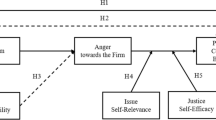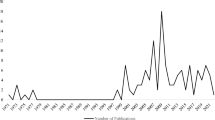Abstract
This paper argues that making goods or services illegal results in an increase in the social costs associated with rent-seeking. The increased social cost is in the form of negative externalities that result from market participants use of coercion and violence in attempts to control trade in the illegal good. Consequently, the social costs of rent-seeking will exceed the value of resources dissipated in rent-seeking competition. And, where the external costs exceed the undissipated portion of the Tullock cost, the social cost of rent-seeking is greater than the sum of Tullock and Harberger costs.
Similar content being viewed by others
References
Alchain, A.A. and Demsetz, H. (1973). The property right paradigm.Journal of Economic History 33: 16–27.
Becker, G.S. (1968). Crimes and punishment: An economic approach.Journal of Political Economy 76: 169–217.
Becker, G.S. and Stigler, G.J. (1974). Law enforcement, malfeasance, and compensation of enforcers.Journal of Legal Studies 3: 1–18.
Benson, B. (1984). Rent-seeking from a property rights prospective.Southern Economic Journal 51: 388–400.
Congleton, R.D. (1989). Efficient status seeking: Externalities and the evolution of status games.Journal of Economic Behavior and Organization 11: 175–190.
Corcoran, W.J. (1984). Long-run equilibrium and total expenditures in rent-seeking.Public Choice 43: 89–94.
Corcoran, W.J. and Karels, G.V. (1985). Rent-seeking behavior in the long-run.Public Choice 46: 227–246.
Demsetz, H. (1976). Economics as a guide to antitrust regulation.Journal of Law and Economics 19: 371–384.
Fisher, F. (1985). The social costs of monopoly and regulation: Posner reconsidered.Journal of Political Economy 93.2: 410–416.
Foster, E. (1981). The treatment of rents in cost-benefit analysis.American Economic Review 71: 171–178.
Gabvavi, F. (1989). Licensing and nontransferrable rents: Comment.American Economic Review 79: 906–909.
Harberger, A.C. (1954). Monopoly and resource allocation.American Economic Review 44: 77–87.
Higgins, R.S., Shugart II, W.F. and Tollison, R.D. (1985). Free entry and efficient rent-seeking.Public Choice 46: 247–258.
Hirshleifer, J. (1989). Conflict and rent-seeking success functions: Ratio versus difference models of relative success.Public Choice 63: 101–112.
Kruger, A.O. (1974). The political economy of rent-seeking.American Economic Review 64: 291–303.
Lott, J.R. (1987). Licensing and nontransferrable rents.American Economic Review 77: 453–455.
Lott, J.R. and Roberts, R.D. (1989). Why comply?: One-sided enforcement of price controls and victimless crime laws.Journal of Legal Studies 18: 403–414.
Paul, C. and Wilhite, A. (1990a). Efficient rent-seeking under varying cost structures.Public Choice 64: 270–290.
Paul, C. and Wilhite, A. (1990b). Rent-seeking, rent defending and rent defending and rent dissipation.Public Choice 71: 61–70.
Peltzman, S. (1976). Toward a general theory of regulation.Journal of Law and Economics 19: 211–240.
Posner, R. (1975). The social costs of monopoly and regulation.Journal of Political Economy 83: 807–827.
Rogerson, W.P. (1982). The social costs of monopoly and regulation: A game theoretic analysis.The Bell Journal of Economics 13: 391–401.
Rubin, P. (1973). The economic theory of the criminal firm. In S. Rottenberg (Ed.),The economics of crime and punishment. Washington: American Interprise Institute for Public Policy Research.
Rubin, P. and Paul, C. (1979). An evolutionary model of taste for risk.Economic Inquiry 17: 585–596.
Stigler, G.J. (1971). The theory of economic regulation.The Bell Journal of Economics and Management Science 2: 3–21.
Stigler, G.J. (1975).The citizen and the state. Chicago and London: University of Chicago Press.
Tollison, R.D. (1989). Superdissipation.Public Choice 61: 97–98.
Tullock, G. (1967). The welfare costs of tariffs, monopolies and theft.Western Economic Journal 5: 224–232.
Tullock, G. (1980). Efficient rent-seeking. In J. Buchanan, R.D. Tollison and G. Tullock (Eds.),Toward a theory of the rent-seeking society. College Station: Texas AM Press.
Tullock, G. (1984). Long-run equilibrium and total expenditures in rent-seeking: A comment.Public Choice 43: 95–97.
Wenders, J.T. (1987). On perfect rent dissipation.American Economic Review 77: 456–459.
Zardkoohi, A. and Pustay, M. (1989). Does transferability affect the social costs of licensing?Public Choice 62: 187–190.
Author information
Authors and Affiliations
Rights and permissions
About this article
Cite this article
Paul, C., Wilhite, A. Illegal markets and the social costs of rent-seeking. Public Choice 79, 105–115 (1994). https://doi.org/10.1007/BF01047921
Accepted:
Issue Date:
DOI: https://doi.org/10.1007/BF01047921




